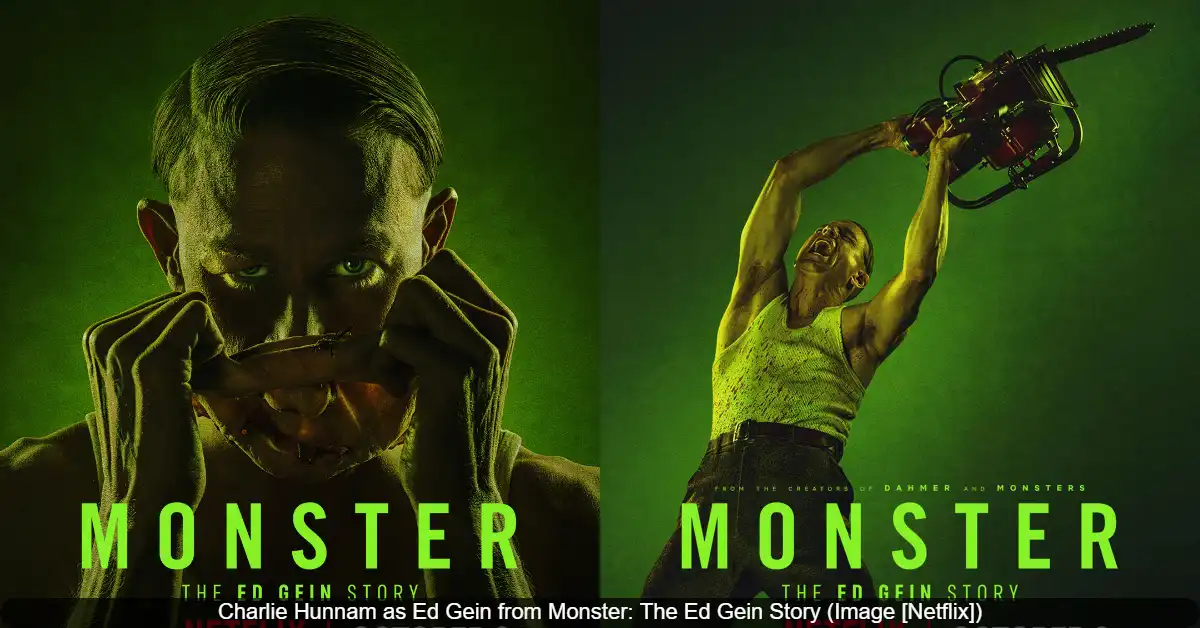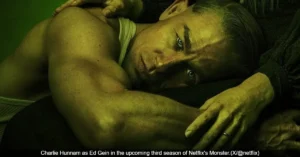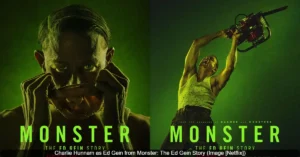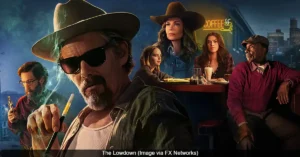The new Netflix series Monster: The Ed Gein Story reveals the shocking true story of the killer whose gruesome crimes became the unlikely blueprint for Hollywood horror. The series shows how a lonely man from a small farm in Wisconsin directly inspired some of the most famous monsters in film history.
The eight-episode season, which debuted on October 3, 2025, is the latest installment in Ryan Murphy and Ian Brennan’s anthology series. It stars Charlie Hunnam as Ed Gein, the mild-mannered recluse whose unthinkable acts in the 1950s would go on to shape the face of horror for decades. His story directly inspired the creation of Norman Bates in Psycho, Leatherface in The Texas Chain Saw Massacre, and Buffalo Bill in The Silence of the Lambs.
The Man Behind the Monster
Ed Gein, often called the “Butcher of Plainfield,” lived on a remote Wisconsin farm with his domineering mother, Augusta, played by Laurie Metcalf. The series portrays his descent into madness, driven by isolation, mental illness, and an all-consuming obsession with his mother. When authorities finally arrested him, they discovered a house of horrors filled with items made from human skin and body parts, including masks, a suit of skin, and furniture crafted from bones.
Charlie Hunnam underwent a significant physical transformation to play the role, losing nearly 30 pounds. He spent months researching Gein to understand the man behind the myths.
“I wanted to get as close as possible to who Ed was, to do him justice, and for this thing to feel authentic,” Hunnam said. “This is going to be the really human, tender, unflinching, no-holds-barred exploration of who Ed was and what he did.”
The series explores the central question that has long surrounded Gein’s story.
“The interesting thing about the show is the thesis statement of every season is: Are monsters born or are they made?” co-creator Ryan Murphy asked. “And I think in Ed’s case, it’s probably a little of both.”
A Direct Line to Hollywood’s Greatest Ghouls
The series cleverly weaves together Gein’s life with the Hollywood stories he later inspired, showing the direct line from his crimes to iconic horror films.
One major storyline follows Alfred Hitchcock, played by Tom Hollander, as he develops the film Psycho. The character of Norman Bates, a man with a troubled relationship with his mother who dresses in her clothes, was directly based on details from Gein’s life and crimes. The series also shows the casting of Anthony Perkins, played by Joey Pollari, for the role that would redefine screen horror.
Later episodes feature Tobe Hooper, played by Will Brill, working on The Texas Chain Saw Massacre. The film’s villain, Leatherface, who wears a mask of human skin, draws from the grisly artifacts found in Gein’s farmhouse. The series also recreates the famous dancing scene from The Silence of the Lambs, whose killer, Buffalo Bill, was another fictional character inspired by Gein’s desire to create a “woman suit” from human skin.
“He is probably one of the most influential people of the 20th century, and yet people don’t know that much about him,” Murphy said. “He influenced the Boogeyman and Psycho. Norman Bates was based on him. He influenced The Silence of the Lambs. He influenced The Texas Chain Saw Massacre.”
A Distorted Mirror and a Warning
Beyond the biography, the series turns a critical eye on the audience’s own fascination with true crime. It suggests that society’s appetite for these gruesome stories is part of the same cycle that turned Gein into a legend. In the trailer, Hunnam’s Gein breaks the fourth wall to tell the viewer, “You’re the one who can’t look away.”
This theme is central to the creators’ vision.
“This whole series, it turns the camera right on us,” co-creator Ian Brennan said. “It really matters what you look at and the images and stories you consume. They do stick with you, and they do have an impact.”
The show also delves into the blurred lines of Gein’s reality. A key relationship in the series is with his only friend, Adeline Watkins, played by Suzanna Son. She introduces him to dark imagery, including pictures of Nazi war criminal Ilse Koch, who becomes a figure in his fantasies. The reality of their relationship was as murky in real life as it is portrayed on screen.
“We do know is that she came out at first talking about how they were an item, and they were going to get married,” Brennan said. “And then she came out like, ‘No, I made that all up.’” The creators ultimately decided to portray Adeline as a real character, though Hunnam himself saw her as partly a fantasy for Gein.
A Legacy Cast in Shadow
Monster: The Ed Gein Story presents a complex portrait of a man who was both a product of severe abuse and the source of unimaginable horror. By connecting his story to the films it spawned, the series makes a compelling case for Gein’s unparalleled influence on popular culture.
“Prior to Psycho coming out, monsters [in movies] were werewolves and Dracula and Frankenstein,” Hunnam observed. “They weren’t your next-door neighbor… It was a complete reimagining of the horror genre.”
The series argues that the most terrifying monsters are not supernatural creatures, but the ones that could be living quietly next door. In doing so, it holds up a dark mirror, asking viewers to consider why they are drawn to these stories and what that says about the world we live in today.
Also Read: Monster: The Ed Gein Story – Did Ed Gein Kill Adeline Watkins?
Credits: Netflix Tudum, Variety









